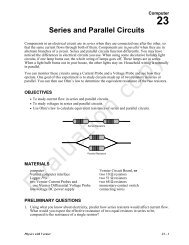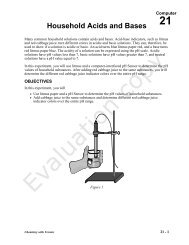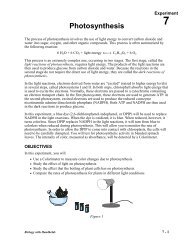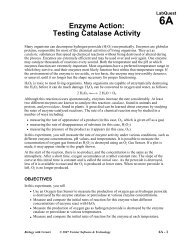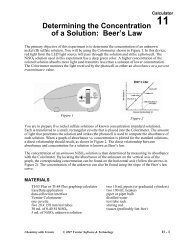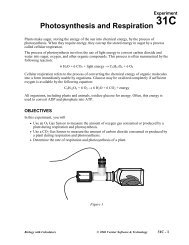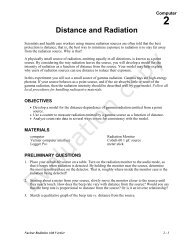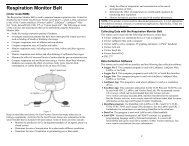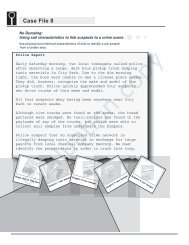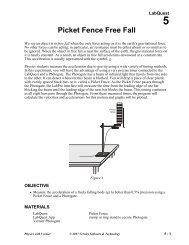Activities for the Wireless Dynamics Sensor System - Vernier ...
Activities for the Wireless Dynamics Sensor System - Vernier ...
Activities for the Wireless Dynamics Sensor System - Vernier ...
You also want an ePaper? Increase the reach of your titles
YUMPU automatically turns print PDFs into web optimized ePapers that Google loves.
<strong>Activities</strong> <strong>for</strong> <strong>the</strong> <strong>Wireless</strong> <strong>Dynamics</strong> <strong>Sensor</strong> <strong>System</strong>12. Print copies of each graph.Trial 213. Attach <strong>the</strong> 0.500 kg mass to <strong>the</strong> cart. Record <strong>the</strong> mass of <strong>the</strong> cart, sensors, andadditional mass in <strong>the</strong> data table. Repeat Steps 9 – 12.DATA TABLETrial IMass of cart with WDSS (kg)Regression line <strong>for</strong> <strong>for</strong>ce vs. acceleration dataTrial 2Mass of cart with WDSS and additional mass (kg)Regression line <strong>for</strong> <strong>for</strong>ce vs. acceleration dataANALYSIS1. Compare <strong>the</strong> <strong>for</strong>ce-time and acceleration-time graphs <strong>for</strong> a particular trial. How are<strong>the</strong>y different? How are <strong>the</strong>y <strong>the</strong> same?2. Are <strong>the</strong> net <strong>for</strong>ce on an object and <strong>the</strong> acceleration of <strong>the</strong> object directly proportional?Explain, using experimental data to support your answer.3. What are <strong>the</strong> units of <strong>the</strong> slope of <strong>the</strong> <strong>for</strong>ce vs. acceleration graph? Simplify <strong>the</strong> unitsof <strong>the</strong> slope to fundamental units (m, kg, s).4. For each trial compare <strong>the</strong> slope of <strong>the</strong> regression line to <strong>the</strong> mass being accelerated.What does <strong>the</strong> slope represent?5. Write a general equation that relates all three variables: <strong>for</strong>ce, mass, and acceleration.EXTENSIONSUse this apparatus as a way to measure mass. Place an unknown mass on <strong>the</strong> cart.Measure <strong>the</strong> acceleration <strong>for</strong> a known <strong>for</strong>ce and determine <strong>the</strong> mass of <strong>the</strong> unknown.Compare your answer with <strong>the</strong> actual mass, as measured using a balance.© 2007 - <strong>Vernier</strong> Software & Technology 29




